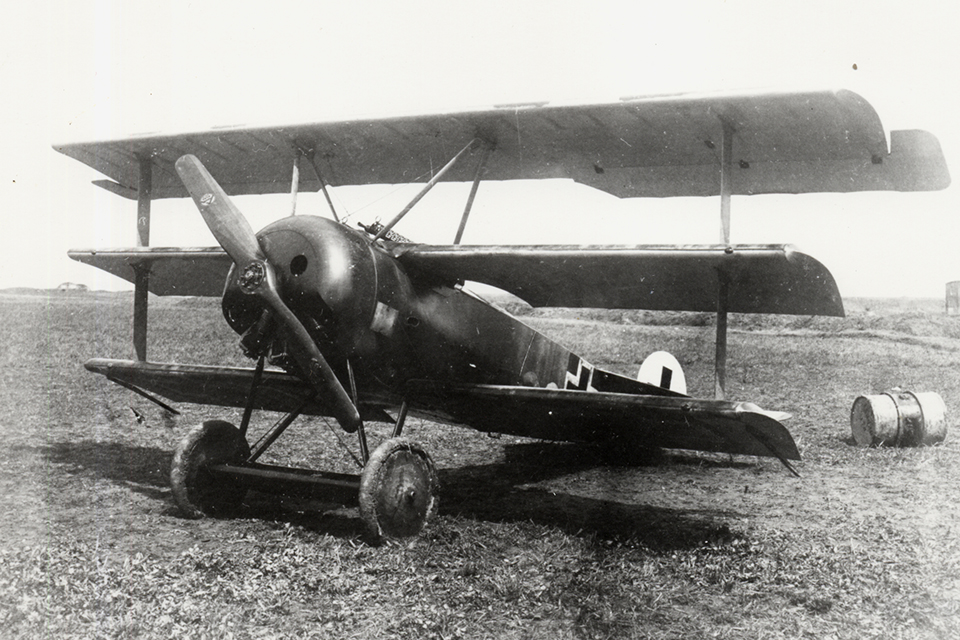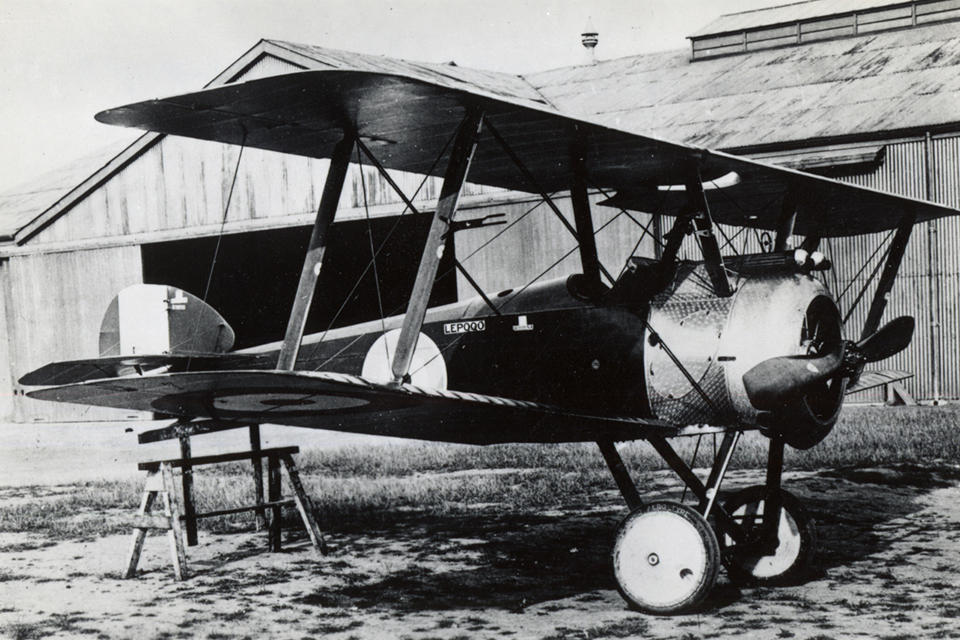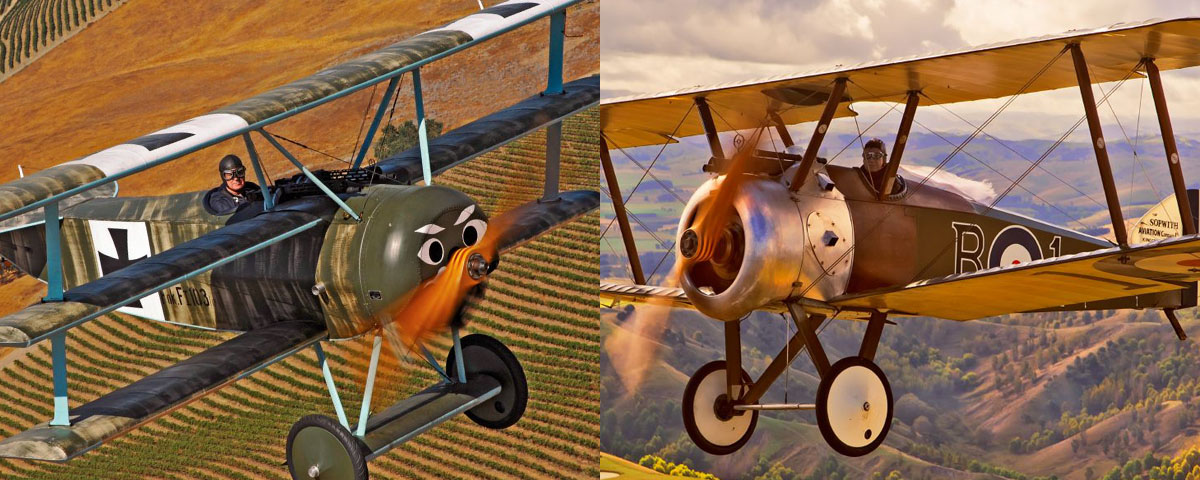German Lieutenant Lothar von Richthofen, younger brother of Manfred, the celebrated “Red Baron,” peered over the cockpit of his Fokker spotting a mixed flight of British Sopwith F.1 Camel fighters and Bristol F.2b two-seaters soaring over the cratered battlefields of France. In a flash, Lothar led his flight into the attack, guns blazing. Suddenly he heard a Dreidecker (triplane), sickening ripping sound. Looking up, he watched helplessly as the fabric on the leading edge of his uppermost wing shredded in the airflow, either due to enemy fire or, more likely, shoddy construction. “My triplane became a biplane,” Lothar later recalled, as his stricken craft went into a steep dive and crash-landed, severely injuring him. Meanwhile in England, Lieutenant Colonel L.A. Strange of the Royal Flying Corps (RFC) watched with his stomach churning as a Camel approached Upavon airfield. Quick as a lash, the fighter flipped over into a dizzying spin and smashed into the ground, instantly killing its novice pilot. “Camels continually spun down out of control when flown by pupils out on their first solos,” Strange laconically commented. It was the spring of 1918, and both the Camel and the Dreidecker had claimed their latest victims—unfortunately not the enemy.
The Fokker Dr.I triplane and the Sopwith Camel are indisputably the two most recognizable fighter aircraft of World War I, indeed, two of the most famous fighters in aerial combat history. Arguably the most recognizable fighter from any war is Manfred von Richthofen’s blood-red Dr.I 425/17, in which he was killed. To this day, Camel and Dreidecker images are everywhere, from model airplane kits to Hollywood films, from bicycles to pizza boxes, from the Peanuts comic strip to countless book and periodical covers. In popular volumes such as Time-Life’s Knights of the Air, the Camel and the Dr.I are presented like sexy pinups— complete with double-page spreads—subconsciously magnifying these planes’ significance in modern minds.
But are their reputations justified? What was the reality of their performance, and their impact on the war effort? Looking at the sheer number of experienced and inchoate pilots killed in these machines, one wonders what all the hype is about.
The Dreidecker and the Camel shared several similarities. Both were introduced in 1917, as the air war was becoming more deadly. The Sopwith F.1, dubbed the “Camel” because of the humped fairing covering its twin Vickers machine guns on the forward cowling, was warmly welcomed by British fliers. For the first time in the war, they could match the firepower of German fighters, which sported double Spandau machine guns. Similarly, the Dreidecker was eagerly received by German pilots, including the Red Baron, who noted the triplanes could “climb like apes and are as maneuverable as the devil.”
Additionally, the Dr.I and Camel replaced outclassed earlier fighters, such as the single-gunned Sopwith Pup, Sopwith Triplane and Nieuport 17 on the Allied side, and the Germans’ effective but structurally weak Albatros D.III to D.Va series. The Camel was a natural developmental progression from the Pup and Triplane, while the Dreidecker was essentially a stopgap response to the impressive climbing abilities of Sopwith’s Triplane.

The Camel and the Dr.I were diminutive, relatively slow and had low ceilings: The Camel had a wingspan of 28 feet, a top speed of 121 mph and a ceiling of 19,000 to 24,000 feet (depending on the engine), while the stubby Dr.I’s wingspan was just 23 feet 7 inches and its top speed was only 115 to 120 mph, with a ceiling of 20,000 feet.
Both fighters had to be flown hands-on all the time. The Dr.I’s three wings created breathtaking lift, and the Camel, with its fuel tanks and pilot packed closely together, was extremely light and nimble. Both were highly maneuverable: Their rotary engines—a 110- hp or 130-hp Clerget, Le Rhône or Bentley, among others, in the Camel; a 110-hp Oberursel in the Dreidecker—produced lightningquick right-hand turns that dazzled opponents in a dogfight, even while terrifying novice pilots.“The new Fokker triplane which I fly is an absolutely splendid craft, tremendously maneuverable and it climbs splendidly,” Captain Adolf Ritter von Tutschek, a 27-victory ace, excitedly wrote in his diary. The Camel, one RAF pilot asserted, “was unquestionably the greatest plane at the front….In a fight it could turn to the right faster than any other plane….”
There is no doubt that in the hands of skilled, experienced and confident pilots the Dr.I and Camel were superior dogfighters and excellent at low-level work. The Camel was particularly good at strafing and bombing ground targets. “They could dive straight down on anything,” remembered Lieutenant Victor Yeates, “and when a few feet off the ground go straight up again.” Lieutenant Josef Jacobs, an ace with 44 or 48 victories (depending on the scorekeeper), wrote that the Dreidecker “at low level…is very maneuverable and equal to the British machines.” After a running ground-level fight with a swarm of 16 British S.E.5as, Captain Tutschek repeatedly outmaneuvered and got above and behind his opponents, noting in his diary on February 2, 1918,“after this day I have a burning love for my Fokker triplane.”
Both opponents respected the prowess of their enemy’s aircraft. Never try “to fight a Triplane at a disadvantage,” RAF Captain Edward Mannock instructed his men, one of whom, when a Dreidecker latched onto his tail, reportedly yanked “his aircraft into a vertical bank, held the stick tight into his stomach, kept his engine full on, and prayed hard” until the German finally broke off the attack.
Prior to its introduction, the Dr.I already enjoyed a formidable reputation thanks to the marketing efforts of its creator, Anthony Fokker, who filmed Richthofen, the war’s highest scoring ace with 80 victories, and other aces test-flying it. Indeed, the Red Baron received the very first Dreidecker and scored the first triplane victory on September 1, 1917, shooting down an RFC R.E.8 two-seater. Produced in small numbers, the triplane was initially assigned only to seasoned aces, further promoting its exclusive allure.
Similarly, the Camel was also flown by several successful Allied aces, such as Major William Barker, 50 victories, and Lt. Col. Raymond Collishaw, who ended the war with a tally of 60. After the conflict, the Camel “starred” in an excellent novel, Winged Victory, written by former Camel pilot V.M. Yeates, and the popular “Biggles” war adventure books by W.E. Johns. And when Peanuts creator Charles Schulz, an avid WWI aviation enthusiast, decided to place Snoopy at the controls of a Camel, perpetually cursing the Red Baron, its reputation was sealed. As if this was not enough, it is oft reported that the Camel scored more victories than any other aircraft type during the war: 1,294.
A closer look at the reality of these two famous fighters, however, reveals a more complex story. First, given RFC (later Royal Air Force) victory accreditation standards, which counted “out of control” as a “kill,” it is more accurate to say that more victories were claimed in Camels than in any other airplane. Second, and most disturbing, the Camel killed many of its own pilots. As 29-victory Australian ace Captain Arthur Cobby recalled: “A great number of trainee pilots had been killed learning to fly this machine, as its tricks took some learning, although they were really simple to overcome. Its main trouble was that owing to its very small wingspan, and its purposely unstable characteristics, coupled with the gyroscopic effect of a rotating engine and propeller, it flipped into a spin very easily at low speeds. Consequently, in landing and taking off, a tremendous number of fatal accidents occurred, and a general feeling of dislike for the machine was prevalent. It really had people frightened.”
As the Camel nosed down in a spin, most novice pilots did the logical thing: They pulled the stick back and applied opposite rudder. Tragically, this was not the cure to lift the Camel out of its deadly spiral. During takeoffs, enough speed had to be developed, with the pilot applying full right rudder to counteract the torque of the spinning rotary engine. Failure to do so often resulted in a loop, with the Camel crashing into the ground on its starboard wingtip. And to recover from a spin, as experienced pilots quickly realized, the key was to center the controls and push the stick forward until the fighter righted itself.
Thus in one awful respect the Camel was indeed king: training casualties. According to statistics compiled by researcher Chris Hobson, the Camel accounted for 16.5 percent of British training casualties, much more than any other type of aircraft during the war. Shockingly, an estimated 385 pilots died from noncombat-related causes while flying Camels, compared to 413 killed in combat.

As with the Camel, the Dreidecker’s reputation is vastly overinflated. A disturbingly large number of German squadron leaders and high-ranking aces were killed in the triplane: Lieutenant Werner Voss (48 victories), Lieutenant Walter Göttsch (20), Lieutenant Heinrich Gontermann (39), 1st Lt. Kurt Wolff (33), Tutschek (27) and of course Imperial Germany’s superstar, Richthofen. Many others crash-landed, resulting in some pilots requiring extended hospitalization, while still others were killed in tragic mishaps, as in the case of Private Günther Pastor (one victory), who died when his Dr.I hit the ground in October 1917 due to wing failure.
The loss of these talented and inspirational combat leaders—as well as the equally important lower ranks—was immense, especially given the comparatively low rate of return. By the end of 1917, for instance, it has been estimated by WWI air combat researchers Norman Franks, Frank Bailey and Russell Guest that only “15 victories would have been scored in these Dreideckers…ten of which were by Voss.”
Indeed, the triplane was so troubled that German military authorities grounded it while a special commission investigated its flaws. Tests revealed poor quality control and substandard construction practices at the Fokker factory. Officials discovered that the Dr.I’s ailerons could break during banks and other maneuvers because of faulty attachments. Furthermore, moisture in the top wing affected glue joints, causing the fabric to rip off in the airstream. There were other concerns as well: With restricted access to the castor oil needed for the rotary engine, the Germans used a synthetic substitute, which led to overheating and breakdowns, particularly in the summer months. In addition, the Dreidecker’s high center of gravity meant it was unstable on the ground and rocked laterally during takeoff and landing; wooden skids were added to the lower wingtips to prevent damage. Production was halted until these potentially deadly faults were remedied, and it wasn’t until the end of November 1917 that the Dr.I was again declared fit for active service.
The Camel, too, was plagued by problems. Rushed into production, some could not reach their operational ceiling in the promised amount of time. Moreover, as Wing Captain C.L. Lambe of the Royal Navy Air Service complained: “The work on Camels has not been satisfactory. Four were sent down with their engine bearers in such a state that it had to be reported….It is obvious that not only had they never been flown, but could never have had engines installed….” On top of this, British-made Clerget motors suffered significant loss of performance with extended use; there were troubles with the Kauper interrupter gear, which enabled the machine guns to fire through the propeller arc; tailskids broke (from March to May 1918, 370 breakages were reported); the port wheel was prone to detaching itself from the undercarriage, causing landing accidents; and the small rudder was “barely adequate,” in the words of Camel expert J.M. Bruce. Moreover, it was an extremely cold aircraft to fly. And its rotary engine—as with the Dr.I— spewed castor oil fumes, afflicting pilots with nausea and digestive tract problems.
By war’s end, 5,695 Camels had been ordered, and the fighter had fought on every front as well as in a home defense role in the UK. Yet the Camel’s contemporaries, such as the excellent French SPAD XIII and the tough and stable British S.E.5a, surpassed it in performance and reliability, reaching speeds of 125 mph and ceilings of up to 22,000 feet. Indeed, one flier bemoaned,“A Camel pilot had to shoot down every German plane in the sky in order to get home himself, as the Camel could neither outclimb nor outrun a Fokker [D.VII].”
The Dreidecker’s impact on the war was minimal. Only 320 were produced, equipping about 14 of 80 German fighter squadrons. It was far superseded by the Albatros D.I to D.Va series, whose production numbers reached more than 4,000 by 1918, and by the superlative Fokker D.VII, rightly considered one of the war’s greatest fighters, with an estimated production run of about 3,200.
As to their illustrious reputations, the Camel and the Dreidecker have both benefited from being the key actors in one of aviation history’s most famous air battles—Richthofen’s last flight on April 21, 1918, when he was pursuing one Camel for his potential 81st victory while being attacked from behind by another. Whether he was shot down by Camel pilot Roy Brown or, more likely, by Australian ground troops, doesn’t seem to matter: What has remained in our collective consciousness is that the Red Baron died in his scarlet triplane while fighting Sopwith Camels.
In reality, however, Richthofen scored less than a quarter of his victories in the Dreidecker. The vast majority of his kills were in Albatros fighters—also painted partially or all red. Moreover, toward the end of his short life, Richthofen was painfully aware of the Dr.I’s limitations, and he wrote to his superiors complaining about its performance. “I would prefer to have the Fokker [D.VII] with the BMW engine or the supercharged Mercedes,” he told them. BMW and Mercedes engines were inline, reliable and powerful; Richthofen had had his fill of troublesome rotaries. In a letter to a friend at German air force headquarters, Richthofen demanded,“When can I count on [receiving] Fokker [D.VII] biplanes and with the super-compressed engines?” He noted that Allied fighters were operating at such high altitudes that “One cannot even shoot at them. The two-seaters drop their bombs without our being able to reach them. Speed is the most important point. One could shoot down five to ten times as many [enemy aircraft] if one were faster.” Given these comments, it is ironic that Richthofen is today so closely associated with the troubled triplane.
The Camel and the Dr.I were touchy, sensitive and agile fighters, creatures of the war that had produced them. In the hands of skilled pilots they were spectacularly responsive, but with novices at the controls they were more deadly to themselves than to their enemy. Both were obsolete by mid-1918, surpassed in performance, safety and reliability by other aircraft. In the final analysis, we should see them for what they really were: flawed fighters, deadly to friend and foe alike.
O’Brien Browne writes from Mannheim, Germany. For further reading, he recommends: Sopwith Camel vs. Fokker Dr I: Western Front 1917-18 and Sopwith Camel, both by Jon Guttman; Sopwith Camel, by J.M. Bruce; The Fokker Triplane, by Alex Imrie; and Fokker Dr I Aces of World War I, by Norman Franks and Greg Van Wyngarden.
Originally published in the September 2013 issue of Aviation History. To subscribe, click here.





